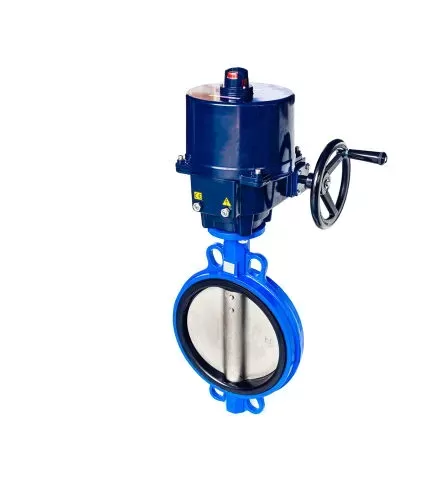Notifications
7 minutes, 32 seconds
-10 Views 0 Comments 0 Likes 0 Reviews

Introduction
Butterfly control valves are essential components in pipeline systems across diverse industries such as water treatment, chemical processing, power generation, and HVAC. While the valve body governs flow regulation, it’s the actuator that determines how efficiently and accurately the valve operates.
Selecting the right actuator for a butterfly control valve is critical for achieving system performance, operational safety, and long-term reliability. Actuators control the movement of the valve disc to open, close, or throttle the flow, with operation methods varying across manual, electric, pneumatic, and hydraulic types.
This comprehensive guide explores the major types of butterfly valve actuators, key selection factors, and their best-use scenarios. Whether you're designing a new system or upgrading existing infrastructure, this guide will help you make an informed and effective choice.
The actuator is the driving mechanism that operates the butterfly valve. It connects to the valve shaft and manipulates the disc to control fluid flow. The effectiveness of this operation depends on choosing an actuator that matches the application’s operational and environmental demands.
Actuators range from basic manual levers to sophisticated automated systems capable of remote monitoring and control. In automated systems, actuators are indispensable for maintaining precise flow regulation with minimal human intervention.
Frequency of Operation
Infrequently operated valves may only require manual actuators. In contrast, high-cycle or continuously modulating systems demand electric, pneumatic, or hydraulic options for automation and efficiency.
Valve Size and Torque Requirements
Larger valves require higher torque. Manual options may be impractical beyond certain sizes without gearboxes. Pneumatic or hydraulic actuators are ideal for high-torque needs due to their compact yet powerful design.
System Pressure and Media Type
For high-pressure systems or those carrying viscous or abrasive media, hydraulic actuators provide superior durability and control. Pneumatic options are suitable for clean, compressed air systems in moderate pressure environments.
Response Time
Fast-acting systems such as emergency shut-offs benefit from pneumatic actuators. Electric actuators, though slower, offer greater control and positioning accuracy.
Power Source Availability
The availability of power—electrical, compressed air, or hydraulic—greatly influences actuator selection. Manual actuators are ideal for remote sites lacking external power.
Environmental Conditions
Hazardous or wet environments may limit the use of electric actuators. Pneumatic and hydraulic systems offer greater resilience in extreme or explosive atmospheres.
Budget Constraints
Manual actuators are the most economical. While electric, pneumatic, and hydraulic actuators involve higher upfront costs, they improve system automation and long-term efficiency.
Overview
Manual actuators operate the valve via handwheels, levers, or gear mechanisms. For larger valves (typically above 12 inches), gearboxes reduce the physical effort needed.
Key Features
No external power required
Simple to install and maintain
Lever or gear-operated options
Best for low-frequency use
Applications
Water supply systems
HVAC installations
Agricultural irrigation
Emergency shutdowns with manual override
Pros
Low cost
Reliable in isolated areas
Fail-safe if left in position
Cons
Not suitable for automation
Labor-dependent
Inefficient for large or high-pressure systems
Overview
Electric actuators use motors (AC or DC) to operate the valve and can be integrated into control systems for precise modulation.
Key Features
Ideal for automation
Excellent positioning accuracy
Equipped with torque limiters and position indicators
Remote diagnostics and control available
Applications
Water treatment plants
Food and pharmaceutical processing
HVAC and building management systems
Pros
Programmable and precise
Quiet operation
Suitable for continuous use
Cons
Slower than pneumatic actuators
Not ideal in explosive or wet environments
Higher initial investment
Overview
These actuators use compressed air to move a piston or diaphragm, which rotates the valve. They’re preferred for rapid, repetitive operation.
Key Features
Fast response time
Double-acting or spring-return types
Supports positioners and limit switches
Lower cost than hydraulic systems
Applications
Chemical and petrochemical plants
Power stations
Fire protection systems
Oil and gas pipelines
Pros
Rapid cycling
Compact and lightweight
Suitable for hazardous environments
Easily automated
Cons
Requires clean, dry air
Noisier without silencers
Air leaks can reduce performance
Overview
Hydraulic actuators utilize pressurized fluid to move a piston, delivering high torque for large or high-pressure valves.
Key Features
Extremely high torque output
Robust and heavy-duty design
Effective under extreme conditions
Available in rotary and linear models
Applications
Offshore and marine platforms
Mining and steel production
High-pressure water systems
Pulp and paper industries
Pros
Best for large-diameter, high-pressure applications
Consistent, smooth operation
Handles extreme environments
Cons
Complex and costly installation
Requires regular maintenance
Risk of fluid leaks
| Actuator Type | Power Source | Best For | Response Time | Automation | Cost | Harsh Environment Suitability |
|---|---|---|---|---|---|---|
| Manual | None | Infrequent, low-demand use | Slow | No | Low | Moderate (basic environments) |
| Electric | Electricity (AC/DC) | Precision control, indoor | Moderate | Yes | Medium | Poor (wet/explosive environments) |
| Pneumatic | Compressed Air | Fast, repetitive operations | Fast | Yes | Med-High | Excellent |
| Hydraulic | Hydraulic Fluid | High torque, heavy-duty use | Fast | Yes | High | Excellent |
Choosing the correct butterfly valve actuator depends on a thorough understanding of system demands, including operational frequency, torque requirements, environmental factors, and power availability.
Manual actuators suit basic, low-frequency operations. Electric actuators are ideal where precision and automation are key. Pneumatic actuators provide speed and durability in demanding applications, while hydraulic actuators deliver robust performance under high pressure and in extreme environments.
By aligning actuator features with your application’s specific needs, you can maximize system efficiency, minimize downtime, and extend the life of your butterfly valve installation.Know more about Google SEO Directory

